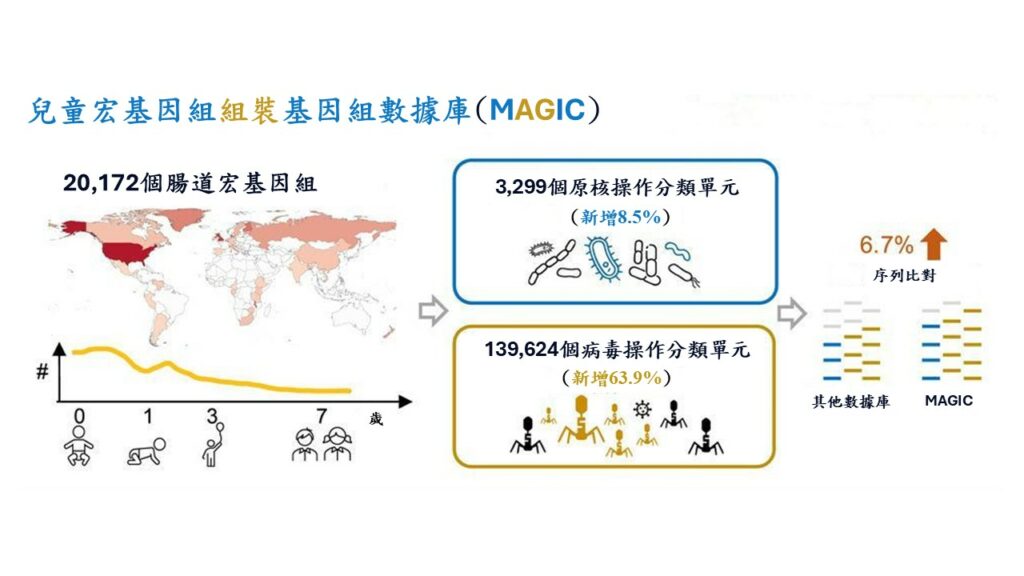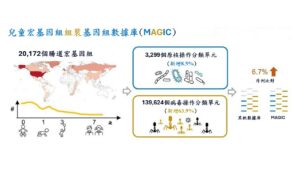CUHK
News Centre
CU Medicine develops the Metagenome-Assembled Genome Inventory for Children (MAGIC) to promote early-life microbiome research
Researchers from The Chinese University of Hong Kong’s (CUHK) Faculty of Medicine (CU Medicine) have developed the Metagenome-Assembled Genome Inventory for Children (MAGIC), a pioneering global database that enhances the understanding of gut microbiome dynamics in early life. The team’s MAGIC database lays a solid foundation for and opens prospects towards studying early-life microbiome research globally given the complex interactions of microbiomes with human health since the inception of life. The findings have been published in the international journal Cell Host & Microbe.
MAGIC database improves early-life microbiome profiling accuracy with extended genomic information
The early-life gut microbiome is crucial for the development of immune and metabolic functions. However, current microbiome databases are primarily based on adult sequences and are predominantly representative of Western populations, which constrains our understanding of infant microbiota maturation and its role in health conditions.
‘‘Comprehensive understanding of the early-life microbiome is vital for promoting long-term health,’’ said senior author of the study Professor Tun Heinmin, Associate Professor of the Jockey Club School of Public Health and Primary Care at CU Medicine and Associate Director of the Microbiota I-Center (MagIC). ‘‘Our MAGIC database, by addressing gaps in age and geographical representation, brings a new hope for advancing fundamental microbiome science and clinical research to promote health through microbiome-targeting therapies,” he added.
The researchers developed the MAGIC database using a robust collection of 20,172 gut metagenomes from children aged 0 to 7 years from 87 geographically diverse studies, including 613 metagenomes from CU Medicine’s birth cohort study MOMmy (MOther-infant Microbiota transmission and its link to long terM health of babY) since 2019. The database encompasses 3,299 prokaryotic and 139,624 viral genomes.
‘‘Remarkably, 8.5% of the prokaryotic and 63.9% of the viral genomes are unique to our MAGIC database. These new sequences enable more accurate profiling of the early-life microbiome. Our study also identified 54 candidate keystone species of the microbial community that are linked to childhood health, revealing associations with geographic and age-related factors,’’ introduced by the lead author of the study, Dr Peng Ye, Postdoctoral Fellow of the Jockey Club School of Public Health and Primary Care at CU Medicine.
Study identifies a connection between key microbial species and infant health highlighting their role in early disease prevention and health promotion
Professor Siew Ng, the other senior author and Croucher Professor in Medical Sciences, Director of MagIC and New Cornerstone Investigator, emphasised the clinical implications of these findings: ‘‘By identifying keystone microbial species, CU Medicine can better understand their roles in infant health and disease development. This knowledge lays the foundation for us to go from zero to one when preventing conditions like allergies early in life.’’
The MAGIC database serves as an important resource to advance personalised medicine for infants, underscoring the importance of early microbial interventions in promoting lifelong health.
One of the corresponding authors of the study, Professor Zhang Lin, Assistant Professor of the Department of Anaesthesia and Intensive Care and Lead Scientist in MagIC of CU Medicine, added: ‘‘Current understanding of the mother-to-infant microbiome is largely skewed towards European and American birth cohorts. The MAGIC database incorporates our Chinese population-based MOMmy metagenomic data for the first time, which will help reinforce China’s role in studying early-life microbiome dynamics internationally.’’
The research team anticipates that their findings will stimulate further research into the role of early-life gut microbiota in health and disease, potentially leading to novel strategies for disease prevention and health promotion.
This study was funded by the Research Grants Council and the InnoHK initiative of the Hong Kong SAR Government.

Featured are research team members: (from left) Professor Lin Zhang, Assistant Professor of the Department of Anaesthesia and Intensive Care and the Lead Scientist in the Microbiota I-Center (MagIC); Professor Siew Ng, Croucher Professor in Medical Sciences, Director of MagIC and New Cornerstone Investigator; Professor Hein Min Tun, Associate Professor of the Jockey Club School of Public Health and Primary Care at CU Medicine and Associate Director of MagIC; as well as Dr Ye Peng, the lead author of the study and Postdoctoral Fellow of the Jockey Club School of Public Health and Primary Care at CU Medicine.




